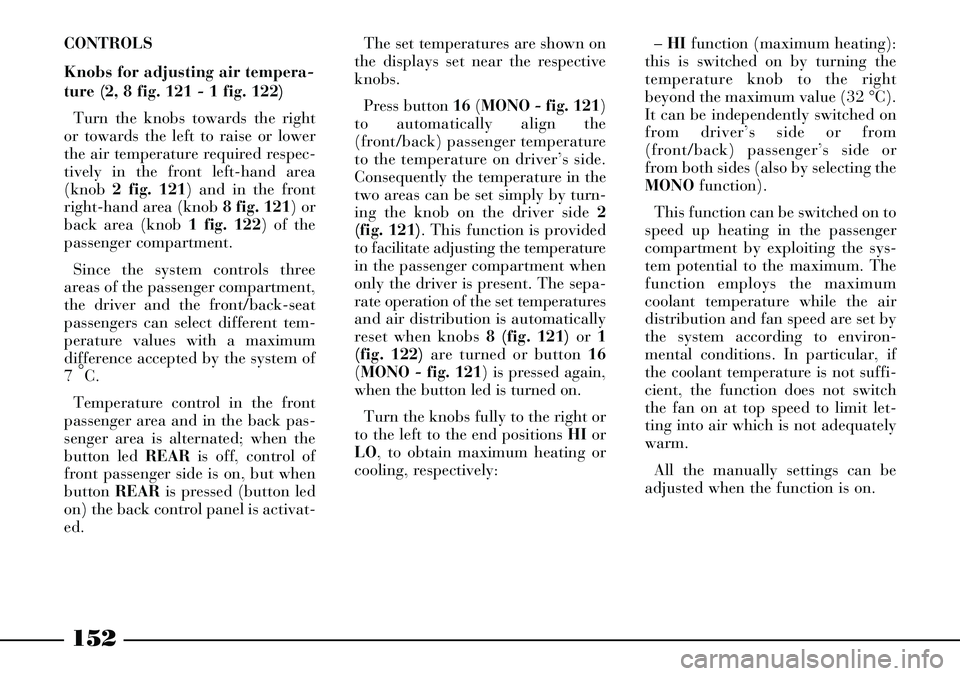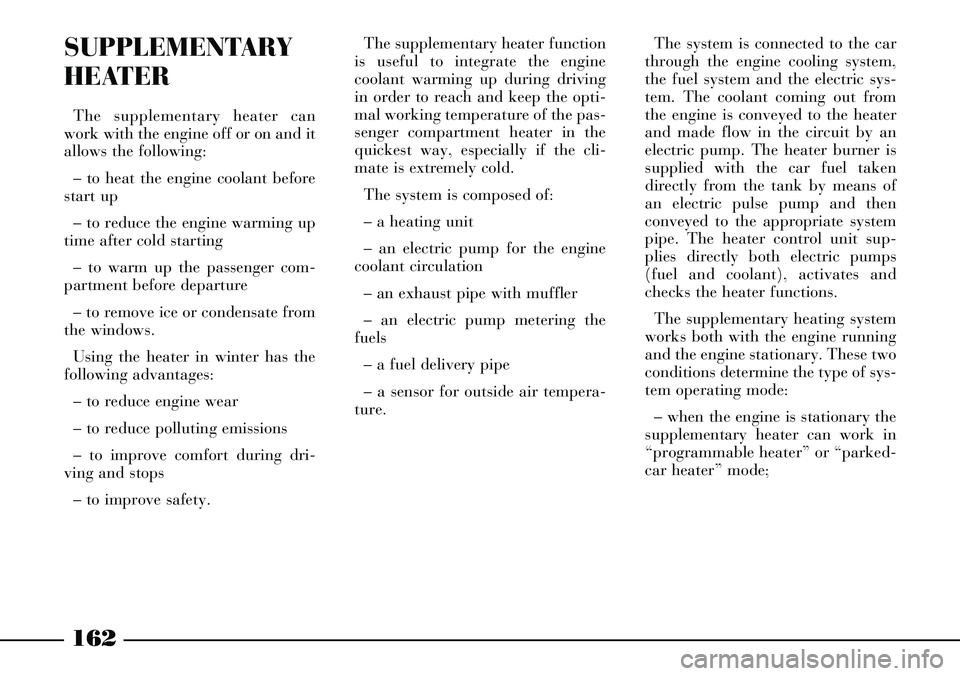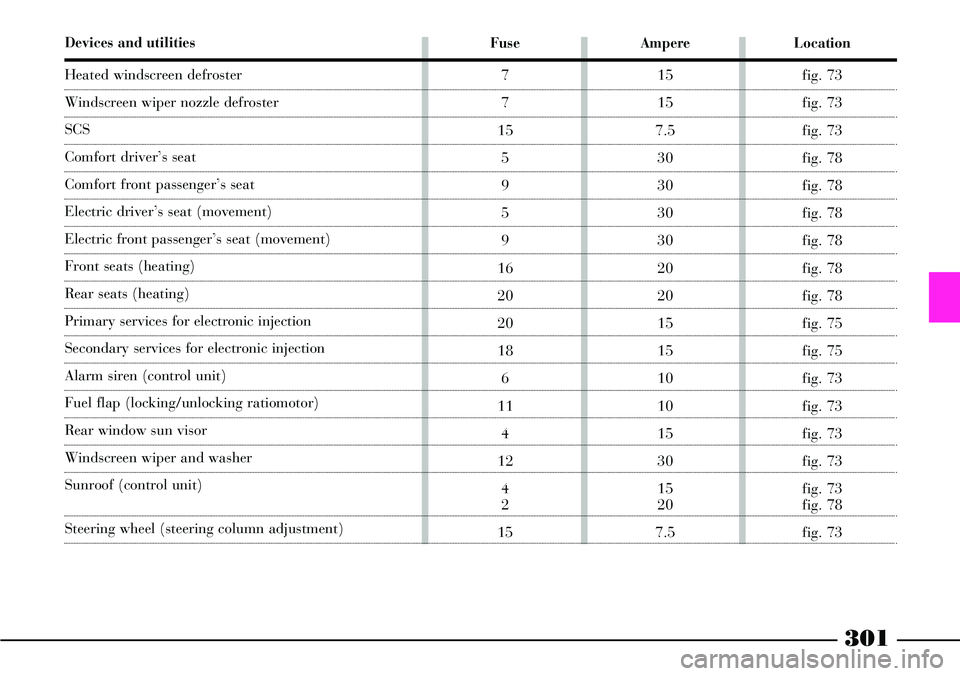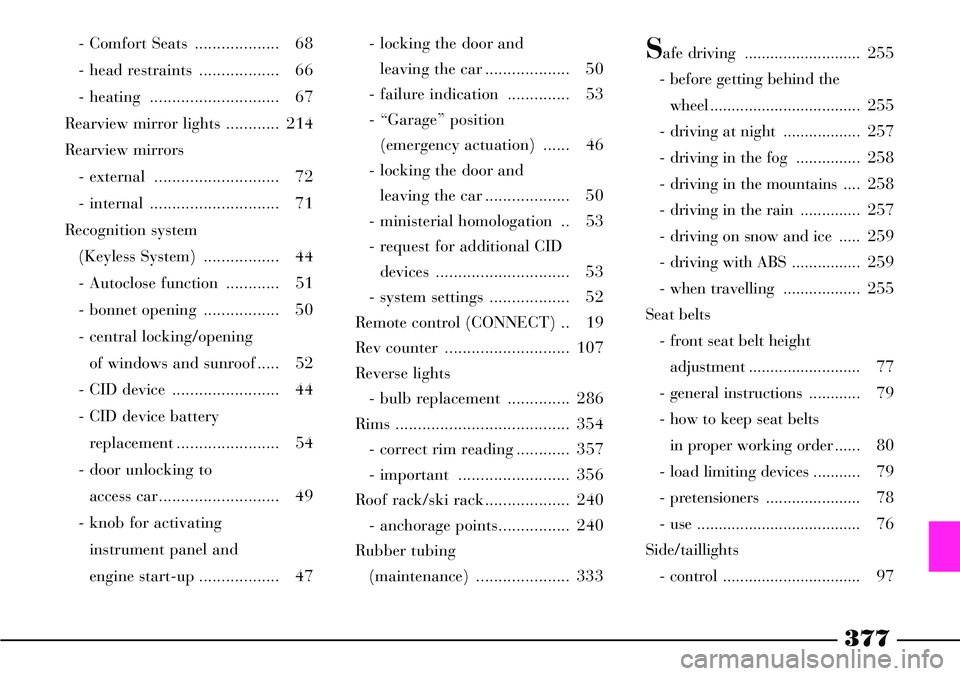heating Lancia Thesis 2006 Owner handbook (in English)
[x] Cancel search | Manufacturer: LANCIA, Model Year: 2006, Model line: Thesis, Model: Lancia Thesis 2006Pages: 386, PDF Size: 8.69 MB
Page 127 of 386

126
Glow plugs (JTD versions)
Warning light/symbol
m
èm
Message
–
PLUG PREHEATING
FAULT
GO TO DEALERMeaning of the message
Symbol is displayed
when glow plugs
are working. Symbol goes off
when glow plugs reach
the preset temperature.
When outside temperature is high
symbol displaying can be unper-
ceivable
Plug preheating system
faultRemarks / Action
Start engine
as soon as symbol
goes off
Contact a Lancia
Dealership
Fuel level
Warning light/symbol
K
Message
REFUEL Meaning of the message
Low fuel in the tank.
This message is displayed
when about 10 litres
fuel are left in the tank Remarks
Top up fuel
as soon as possible
IMPORTANTDo not travel with
the fuel tank almost empty: the
gaps in fuel delivery could damage
the catalyst
Page 153 of 386

152
CONTROLS
Knobs for adjusting air tempera-
ture (2, 8 fig. 121 - 1 fig. 122)
Turn the knobs towards the right
or towards the left to raise or lower
the air temperature required respec-
tively in the front left-hand area
(knob 2 fig. 121) and in the front
right-hand area (knob 8 fig. 121) or
back area (knob 1 fig. 122) of the
passenger compartment.
Since the system controls three
areas of the passenger compartment,
the driver and the front/back-seat
passengers can select different tem-
perature values with a maximum
difference accepted by the system of
7 °
C.
Temperature control in the front
passenger area and in the back pas-
senger area is alternated; when the
button led REARis off, control of
front passenger side is on, but when
button REARis pressed (button led
on) the back control panel is activat-
ed. The set temperatures are shown on
the displays set near the respective
knobs.
Press button 16(MONO - fig. 121)
to automatically align the
(front/back) passenger temperature
to the temperature on driver’s side.
Consequently the temperature in the
two areas can be set simply by turn-
ing the knob on the driver side 2
(fig. 121). This function is provided
to facilitate adjusting the temperature
in the passenger compartment when
only the driver is present. The sepa-
rate operation of the set temperatures
and air distribution is automatically
reset when knobs 8 (fig. 121) or 1
(fig. 122) are turned or button 16
(MONO - fig. 121) is pressed again,
when the button led is turned on.
Turn the knobs fully to the right or
to the left to the end positions HIor
LO, to obtain maximum heating or
cooling, respectively:– HIfunction (maximum heating):
this is switched on by turning the
temperature knob to the right
beyond the maximum value (32 °C).
It can be independently switched on
from driver’s side or from
(front/back) passenger’s side or
from both sides (also by selecting the
MONOfunction).
This function can be switched on to
speed up heating in the passenger
compartment by exploiting the sys-
tem potential to the maximum. The
function employs the maximum
coolant temperature while the air
distribution and fan speed are set by
the system according to environ-
mental conditions. In particular, if
the coolant temperature is not suffi-
cient, the function does not switch
the fan on at top speed to limit let-
ting into air which is not adequately
warm.
All the manually settings can be
adjusted when the function is on.
Page 154 of 386

153
To switch this function off, turn
the temperature knob to the left and
set the required temperature.
– LOfunction (maximum cooling):
it is activated by turning the temper-
ature knob to the left beyond the
minimum value (16 °C). It can be
independently switched on from dri-
ver’s side or from (front/back) pas-
senger’s side or from both sides (also
by selecting the MONOfunction).
This function can be switched on to
speed up cooling the passenger com-
partment by exploiting the system
potential to the maximum. This
function cuts out the heater and
switches the air recirculation and the
climate control compressor on. The
air distribution and the fan speed
are selected according to the envi-
ronmental conditions. All the manu-
ally settings can be adjusted when
the function is on. To switch this
function off, turn the temperature
knob to the right and set the
required temperature.Buttons for adjusting front air
distribution (10, 18 fig. 121)
Press these buttons to manually
select one of the seven possible air
distribution patterns in the front
passenger compartment (right and
left side):
AAir flow to windscreen and front
side window vents for defrosting/
demisting the windows.
FDAir flow to central and side
dashboard vents and the rear vents.
IMPORTANTOn versions equipped
with solar cell operated sunroof
(where provided), to check opera-
tion at first speed of climate control
system fan when the car is parked,
disengage air vents and set air distri-
bution from central dashboard vents
only before leaving the car.
SAir flow to the front and rear
footwells. The air distribution pat-
tern, due to the natural tendency of
heat to move upwards, allows to
heat the passenger compartment up
as fast as possible. Furthermore, it
offers a prompt feeling of warmth to
the coolest parts of the body.Air flow shared between
footwell vents (warmer air)
and central and side dashboard
vents and the rear vents (cooler air).
This air distribution pattern is par-
ticularly useful in middle seasons
(spring and autumn) when it is
sunny.
Air flow shared between the
footwell vents and the windscreen
and front side window
defrosting/demisting vents. This air
distribution pattern ensures a good
heating of the passenger compart-
ment and prevents possible misting
up.
Air flow distribution between
central and side dashboard
vents, rear vents and windscreen
and front side window vents.
Air flow distribution
between all passenger com-
partment vents.
Air distribution setting is displayed
when leds relevant to the selected
button are lit, which will be turned
off in case of fully automatic opera-
tion (FULL AUTO). F
SD
A
S
FA
D
FA
SD
Page 159 of 386

158
IMPORTANTAir at a temperature
lower than that of the outside air
cannot be let in to the passenger
compartment when the compressor
is off. Furthermore, in particular
environmental conditions, the win-
dows could mist up fast because the
air is no longer dehumidified.
The setting will be stored when the
engine is stopped. Either press √
button again or press the AUTObut-
ton to reset automatic control of the
compressor (in the latter case, the
manual settings will be cancelled).
The led on the √button will go out. IMPORTANTThe air recircula-
tion function will allow, according to
the system operation (i.e. heating or
cooling) to reach the required condi-
tions faster. We recommend not
turning on this function on rainy
and/or cold days as this will consid-
erably increase window misting,
especially if the climate control sys-
tem is off.
In particular climate
conditions (e.g. low out-
side temperature or high
humidity) and with the inside air
recirculation automatic control
on, windows could start misting
up. In this case, press the air
recirculation button and set it to
forced open position (both button
leds off), and increase air flow to
the windscreen, if required.Climate control system
compressor off button (7 fig. 121)
Press the √button, when the but-
ton led is on, to switch the air condi-
tioner compressor off. The led will
go off. By pressing again the button
when the led is off, the system auto-
matic control of the compressor acti-
vation is restored; this situation is
indicated by button led lighting up.
When the air conditioner compres-
sor is off, if the system is no longer
able to keep the requested tempera-
ture, the message FULL AUTOon
the display turns off and the system
deactivates air recirculation to pre-
vent window misting up. Instead, if
the system is still able to maintain
the requested temperature, the mes-
sage FULLon the display will stay
on.
Page 163 of 386

162
SUPPLEMENTARY
HEATER
The supplementary heater can
work with the engine off or on and it
allows the following:
– to heat the engine coolant before
start up
– to reduce the engine warming up
time after cold starting
– to warm up the passenger com-
partment before departure
– to remove ice or condensate from
the windows.
Using the heater in winter has the
following advantages:
– to reduce engine wear
– to reduce polluting emissions
– to improve comfort during dri-
ving and stops
– to improve safety.The supplementary heater function
is useful to integrate the engine
coolant warming up during driving
in order to reach and keep the opti-
mal working temperature of the pas-
senger compartment heater in the
quickest way, especially if the cli-
mate is extremely cold.
The system is composed of:
– a heating unit
– an electric pump for the engine
coolant circulation
– an exhaust pipe with muffler
– an electric pump metering the
fuels
– a fuel delivery pipe
– a sensor for outside air tempera-
ture.The system is connected to the car
through the engine cooling system,
the fuel system and the electric sys-
tem. The coolant coming out from
the engine is conveyed to the heater
and made flow in the circuit by an
electric pump. The heater burner is
supplied with the car fuel taken
directly from the tank by means of
an electric pulse pump and then
conveyed to the appropriate system
pipe. The heater control unit sup-
plies directly both electric pumps
(fuel and coolant), activates and
checks the heater functions.
The supplementary heating system
works both with the engine running
and the engine stationary. These two
conditions determine the type of sys-
tem operating mode:
– when the engine is stationary the
supplementary heater can work in
“programmable heater” or “parked-
car heater” mode;
Page 220 of 386

219
REAR BOTTLE/CAN HOLDER
(fig. 178)
Bottle/can holder Ais incorporated
in the rear armrest.
To open it, press on the point spec-
ified by the arrow, then release it:
the bottle/can holder will automati-
cally open.
To close the bottle/can holder,
push it into its seat.REAR ARMREST
COMPARTMENT
Inside the rear armrest is an odd-
ment compartment A(fig. 179), a
card holder Band a power socket C.
Depending on versions, the armrest
can also include:
– the control buttons for heating,
massage, lumbar adjustment and for
adaptation of rear side seats
– the button to shift the front pas-
senger’s seat
– the button to actuate the electric
window shades
fig. 178
L0A0073b
fig. 179
L0A0075b
fig. 177
L0A0252b
CENTRAL CONSOLE
COMPARTMENT (fig. 177)
Versions with automatic, two-zone
climate control system are provided
with an oddment compartment A,
placed on the rear part of the central
console.
Page 301 of 386

300
Devices and utilities
Passenger door point (power supply)
Instrument panel point
Steering angle sensor point
(*) As an alternative for certain versions/markets
Parking sensor point
TV tuner point
Boot point
Steering wheel point
Central console control panels
Fuel pump
Doors (electrified lock actuators)
Spark plug pre-heating
EOBD system diagnostic socket
Current socket in boot
Current socket in rear armrest
Parking heater (control unit)
Additional heater
Fuse
10
14
16
19 (*)
13 (*)
19
15
14
15
11
15
15
21
11
2
6
22
13
2
3
4
9
Ampere
20
10
10
10
10
7.5
7.5
10
7.5
20
7.5
7.5
15
20
60
10
20
20
15
20
50
20
Location
fig. 73
fig. 73
fig. 73
fig. 78
fig. 73
fig. 73
fig. 73
fig. 78
fig. 73
fig. 78
fig. 73
fig. 73
fig. 75
fig. 78
fig. 75
fig. 73
fig. 73
fig. 78
fig. 73
fig. 78
fig. 75
fig. 75
Page 302 of 386

301
Devices and utilities
Heated windscreen defroster
Windscreen wiper nozzle defroster
SCS
Comfort driver’s seat
Comfort front passenger’s seat
Electric driver’s seat (movement)
Electric front passenger’s seat (movement)
Front seats (heating)
Rear seats (heating)
Primary services for electronic injection
Secondary services for electronic injection
Alarm siren (control unit)
Fuel flap (locking/unlocking ratiomotor)
Rear window sun visor
Windscreen wiper and washer
Sunroof (control unit)
Steering wheel (steering column adjustment)
Ampere
15
15
7.5
30
30
30
30
20
20
15
15
10
10
15
30
15
20
7.5
Location
fig. 73
fig. 73
fig. 73
fig. 78
fig. 78
fig. 78
fig. 78
fig. 78
fig. 78
fig. 75
fig. 75
fig. 73
fig. 73
fig. 73
fig. 73
fig. 73
fig. 78
fig. 73
Fuse
7
7
15
5
9
5
9
16
20
20
18
6
11
4
12
4
2
15
Page 375 of 386

374
Front fog lights
- bulb replacement ............... 285
- control .............................. 171
Front passenger presence sensor
(airbag) ................................ 91
Front seats ............................. 60
- armrests ............................. 65
- Comfort Seats ................... 64
- electrically adjustable
seats ................................. 60
- head restraints .................. 65
- heating ............................. 62
- manually adjustable seats
(moving the seat backward
and forward) .................... 60
- paper pockets .................... 221
- storing the driver’s seat
positions ............................ 62
Fuel
- consumption ..................... 366
- cut-off switch .................... 173
- fuel tank cap ..................... 238- level gauge ........................ 108
Fuel consumption ................... 366
Fuel cut-off switch and circuit
breaker................................. 173
Fuel evaporation canister ....... 6
Fuel feed/ignition
- technical specifications ...... 346
Fuel filler cap .......................... 238
Fuel gauge............................... 108
Fuses (replacing) .................... 292
- fuses ................................. 296
- fuses in the boot ................ 295
- fuses in the dashboard ....... 294
- fuses in the engine
compartment ..................... 294
- general .............................. 292
- general fuses ..................... 293
- location ............................. 293
Getting to know your car.... 12
Glove compartment ................ 216
Glove compartment light
- bulb replacement .............. 289
Handles ................................ 221
Hazard lights ........................ 170
Headlight washer
- control .............................. 101
- fluid .................................. 324
Headlights
- (Bi-Xeno) gas-discharge
lamps ................................. 241
- headlight orientation
for left-/right-hand drive .. 243
Head restraints
- front ................................. 65
- rear ................................... 66
Heated rear window ............... 172
Identification data ................. 341
- bodywork paint
identification plate ............. 342
- chassis marking ................ 341
- engine marking ................. 341
- model plate ....................... 341
Page 378 of 386

377
- Comfort Seats ................... 68
- head restraints .................. 66
- heating ............................. 67
Rearview mirror lights ............ 214
Rearview mirrors
- external ............................ 72
- internal ............................. 71
Recognition system
(Keyless System) ................. 44
- Autoclose function ............ 51
- bonnet opening ................. 50
- central locking/opening
of windows and sunroof ..... 52
- CID device ........................ 44
- CID device battery
replacement ....................... 54
- door unlocking to
access car........................... 49
- knob for activating
instrument panel and
engine start-up .................. 47- locking the door and
leaving the car ................... 50
- failure indication .............. 53
- “Garage” position
(emergency actuation) ...... 46
- locking the door and
leaving the car ................... 50
- ministerial homologation .. 53
- request for additional CID
devices .............................. 53
- system settings .................. 52
Remote control (CONNECT) .. 19
Rev counter ............................ 107
Reverse lights
- bulb replacement .............. 286
Rims ....................................... 354
- correct rim reading ............ 357
- important ......................... 356
Roof rack/ski rack................... 240
- anchorage points................ 240
Rubber tubing
(maintenance) ..................... 333Safe driving ........................... 255
- before getting behind the
wheel ................................... 255
- driving at night .................. 257
- driving in the fog ............... 258
- driving in the mountains .... 258
- driving in the rain .............. 257
- driving on snow and ice ..... 259
- driving with ABS ................ 259
- when travelling .................. 255
Seat belts
- front seat belt height
adjustment .......................... 77
- general instructions ............ 79
- how to keep seat belts
in proper working order ...... 80
- load limiting devices ........... 79
- pretensioners ...................... 78
- use ...................................... 76
Side/taillights
- control ................................ 97